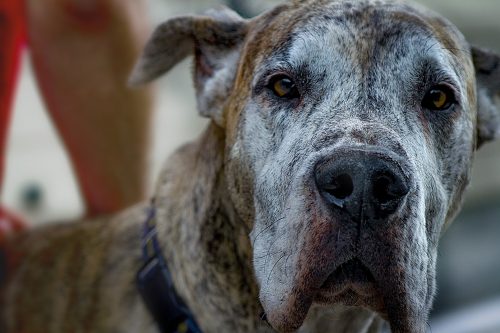Throughout the course of your dog’s life, he may experience different allergies, diet changes, skin disorders, and other kinds of health conditions that you may not be familiar with. The important thing is to pay attention to your pet’s behavior and take notes when he’s acting unusual or seems to be in pain. Since dogs can’t communicate with you in words, you have to rely on their actions in order to understand how they are feeling.
One condition not readily known among dog owners is pemphigus. This medical term references an autoimmune disease in your dog that results in crusting of the skin and the formation of cysts or pus-filled sacs or lesions, which means the signs of it should be highly noticeable when it appears on your pet. There are various types of pemphigus and the reaction of the autoimmune disease is a result of the body essentially attacking itself.
Types of pemphigus in dogs include: pemphigus vegetans, pemphigus foliaceus, pemphigus erythematosus, and pemphigus vulgaris. Pemphigus vegetans only affects dogs (while other strains can affect other animals as well) and is quite rare, but gentler than pemphigus vulgaris.
Your dog’s veterinarian will be able to identify the type of disease your dog has by the symptoms presented, but it’s also a good idea to record any you’ve seen as well. Each of these four types will have its own set of symptoms; although, some may overlap and may not be automatically conclusive of what kind of pemphigus your dog is suffering from. The best thing to do is take your dog in for an exam as soon as possible.
Symptoms of Pemphigus in Dogs by Type

- Vegetans – Your dog may suffer from ulcers, fevers, and in some cases, pus-filled lesions. Typically, the mouth is not affected. This is considered on the more “mild” side of pemphigus, but can still cause your dog pain and discomfort.
- Foliaceus – This type of the disease is more visibly noticeable on the skin. Your dog may develop crusty skin, redness, and pustules. This appears most commonly on the head, ears, and paws. Look out for cracking of your dog’s footpads, the appearance of fluid-filled sacs, and swelling, especially around the lymph nodes. When your dog suffers from pemphigus foliaceus, the appearance of his fur and skin will look painful.
- Erythematosus – This type of pemphigus is similar to the symptoms found with foliaceus, but an additional characteristic is a change or loss in color in your dog’s lips.
- Vulgaris – As the name might suggest, this is the most extreme types of the disease. In addition to blisters, cracked skin, and other noticeable symptoms that cause pain to your pet, bacterial infections and fever are also common. Other areas of the body, such as the groin and underarms, may also be affected.
It’s always a good idea to perform regular checks of your dog’s skin, especially if he is outside a lot. Not only will you see the symptoms of pemphigus, if he has it, but also be aware of any lacerations or tender spots that are causing your pet pain.
Don’t try to diagnose or treat pemphigus on your own. Even if you only notice one or two of the symptoms mentioned, you can’t confidently confirm the diagnosis without the assessment of a veterinarian. It’s not a condition that heals on its own so you’ll want to make the trip to the clinic to get things checked out for your dog.
What Causes Pemphigus in Dogs?
Some of it may be hereditary in some breeds, since there are certain types of dogs who are more prone to diseases than others. Akitas, Doberman Pinschers, Dachshunds, and Newfoundlands may all be more susceptible to pemphigus than other breeds. The development of autoantibodies is also a cause, since it is an autoimmune disease, but one of the most common causes is excessive exposure to the sun.
Whenever the temperature goes up, there are always warnings that go around about leaving your dog in a hot car. That’s advisable not only for your dog’s comfort, but for his safety as well. Even if your dog likes to lay in the sun, he can still be affected by the heat in many ways, including pemphigus.
People don’t normally put sunblock on their dogs or make sure they’re covered when out in the sun because they know their fur will help serve as a protective barrier. While this is true, extreme heat or a long time in the heat can cause your dog’s skin to blister and develop sores as a reaction.
It’s especially important to pay attention to your dog’s behavior after he’s been out in the sun for an extended period of time. Dehydration isn’t the only condition to be on the lookout for; there are most likely other visible signs that your pet is in distress from the sun. Dogs are resilient animals, but they still need proper care and attention from environmental elements.

How Is Pemphigus Diagnosed?
There are symptoms that may point to a pemphigus diagnosis, but there are other diseases that have similar signs, too. Bacterial or fungal infection, ringworm, and other types of skin diseases in dogs may cause redness, itching, and pustules on your pet. In order to determine whether your pet actually has pemphigus, your veterinarian may choose to do a skin biopsy test.
When white blood cells and separated cells are found through the biopsy, the test will result in a positive reading for pemphigus. It’s important to have the proper diagnosis in order for treatment to be effective. Your dog’s doctor can rule out other diseases and any other conditions that may accompany pemphigus.
That way your pet can be prescribed the right medication, steroids, or antibiotics necessary to treat the problem(s) uncovered. If you’re unsure or want to confirm your pet’s diagnosis, consider seeking a second opinion.
Treatment for Pemphigus in Dogs
After your dog has been diagnosed with pemphigus, your vet may recommend that he stay at the clinic until his condition is under control. Following that, your veterinarian will determine the next steps of treatment based on the type of pemphigus he’s diagnosed with. Steroid therapy or other medications may be prescribed, which may also lead to a change in your dog’s diet to avoid possible side effects.

You will need to take your dog to the veterinary clinic for follow-up care until it’s deemed he’s in remission. In the meantime, it’s important that your dog is not exposed to too much sun and follows the medication regimen prescribed. Despite the fact that pemphigus can also affect humans, the condition is not contagious and can’t be transferred from dog to dog owner or vice-versa. However, treatment will take time and in the most serious conditions, it can be fatal for dogs.
In addition to medicinal remedies, there are also natural remedies you can try to help with your dog’s pain and discomfort. Acupuncture, massage, or acupressure are common methods people turn to for help.
If you’ve never exposed your pet to this kind of treatment, you may find out he responds well to these alternative methods. Find out from your veterinarian what’s recommended and get more information about options for your pet.
Keeping Your Dog Out of the Sun
If your dog is being treated for pemphigus or you feel he is more susceptible to it, then try to keep him shaded as much as possible. While it’s not necessarily realistic to keep your dog cooped up indoors all day long, there are ways to limit sun exposure for your pet.
- Avoid the hottest times of the day. For humans, it’s advised not to be outside doing strenuous activity during the peak hours of 10:00 AM and 2:00 PM, especially in the summer when the sun is at its highest point and can do the most harm. Same goes for your pet. If possible, keep your dog out of the sun during this time and schedule walks or outdoor playtime for earlier in the morning or later in the evening when it’s cooler out.
- Create a shaded area in the backyard. Whether your dog has his own house in the backyard or just a special area he likes to lay, make sure there is reprieve from the sun, so he’s not sitting directly in its rays during the day. It can be as simple as setting up an outdoor umbrella or even a tent your dog can go and relax in if he wants to spend time outside.
- Apply canine sunblock. There are sun care products on the market now that can help protect your dog’s fur and skin from the sun. Carefully read the instructions for how often and how much you need to apply. Also, if you’re going to be outside for an extended period of time, don’t forget to use more as necessary.
- Keep cool water available. It’s a good idea to keep a fresh water source both indoors and outdoors, when possible. Since warm weather can immediately make your dog’s water dish go from cool and refreshing to lukewarm or worse, replenish the water often so he and his skin can stay hydrated.
- Provide coverage for your dog wherever you go. If you’re headed to the lake, the beach, or just out running errands with your pet, make sure he has coverage from the sun if he’s going to be out in it for hours at a time. Dogs typically like to lay in the sun, but too much exposure for a dog suffering from pemphigus is not beneficial to his health. You may have to help your pet find a new spot when you go places or even at home that’s out of the sun.
Common Questions About Pemphigus in Dogs
Can my dog recover from pemphigus?
While your pet can go into remission following continued treatment for pemphigus, your dog won’t be considered healed. Without treatment, the symptoms will appear and progress.
Is it possible my dog is not showing any outward symptoms?
No. Each type of pemphigus comes with clearly visible signs since it’s a skin disease. Your dog may also experience unseen symptoms, but with pemphigus, you’ll see crusty skin, pustules, or both.

Does my dog’s diet contribute to his likelihood of getting pemphigus?
No. In most cases, pemphigus is hereditary. However, it’s always a good idea to regulate your pet’s diet regardless of what he’s been diagnosed with.
If my dog is diagnosed with pemphigus, can I ever take him out when it’s sunny?
Yes. You don’t have to avoid sun exposure when your dog has pemphigus, but you do want to limit the amount of sun he gets. The sun can worsen your dog’s condition, so you’ll want to avoid excessive amounts.
A Healthy Pet Is a Happy Pet
In addition to monitoring your dog’s time in the sun, keeping your pet healthy tops the list of priorities. The more you get to know your dog’s health history and what he does or doesn’t respond well to, you can start to identify treatments and ways to maintain his health.
Although pemphigus isn’t preventable, there are ways you can improve your pet’s health and make him feel as good as he can. A solid diet is necessary for dogs to get the nutrients and vitamins they need to thrive. Choosing organic products will aid your dog’s digestion, while giving him the nutrition he needs to feel his best.
In addition to healthy eating habits, ensure your pet is getting enough exercise and rest. For dogs that may be caged most of the day or not taken out as frequently as you’d like, a trip to the dog park or a long walk around the neighborhood helps keep your pet active. This helps strengthen your dog’s muscles, gets his blood circulation flowing, and makes him feel better overall.
When you follow healthy habits, it’s easier to identify when something is amiss in your pet. Unusual skin-related symptoms, like that occur with pemphigus, will be more noticeable if your dog is otherwise healthy. Be proactive about your pet’s health and find the kind of wellness regimen that works best.




